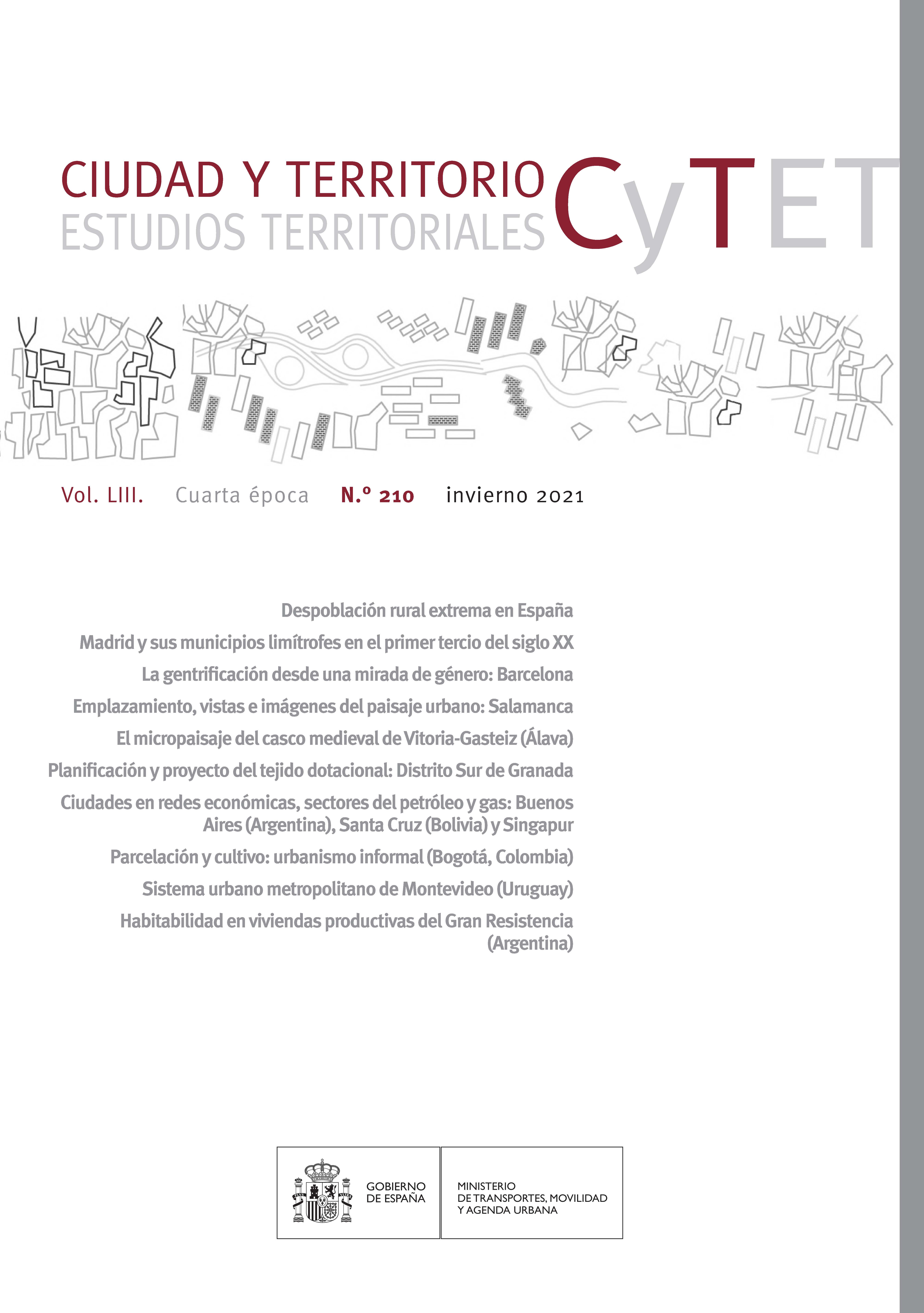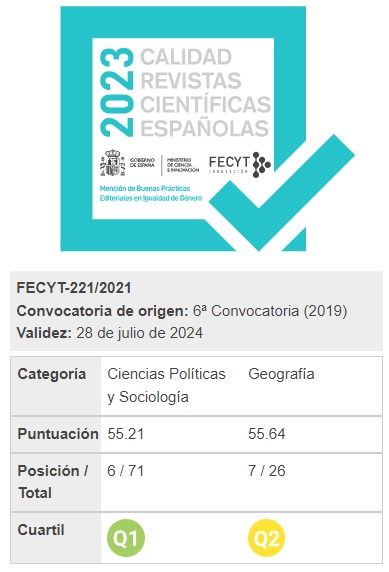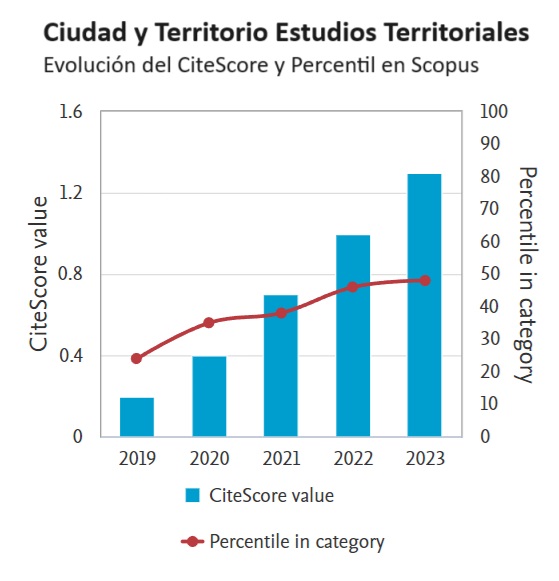Gentrification from a gender perspective: evidence from Barcelona
DOI:
https://doi.org/10.37230/CyTET.2021.210.03Keywords:
Social and urban transformation, Gentrification, Gender, BarcelonaAbstract
This article examines the recent processes of social and urban transformation in Barcelona in order to identify differential experiences and behaviours between men and women. We start from a quantitative exploration, from a gender perspective, of the sociodemographic gentrification processes experienced in Barcelona between 2011-2018. We follow with a qualitative analysis based on interviews to residents and observations in community groups in Sant Antoni, a neighbourhood of Barcelona that has experienced intense transformations of its urban and social fabric. We focus on the impact of gentrification on women with diverse identities who live under strong job and residential insecurity, and female residents who recently arrived to the neighbourhood attracted by its centrality and the concentration of services and retail activities.
Downloads
References
Anguelovski, I. (2014): Neighborhood as refuge: Community reconstruction, place remaking, and environmental justice in the city, Cambridge, The MIT Press.
Antón-Alonso, F. & Porcel, S. & Cruz, I. (2018): Factors contextuals associats als processos de gentrificació de l’àrea metropolitana de Barcelona. Papers: Regió Metropolitana de Barcelona: Territori, estratègies, planejament, 60: 64-79.
Atkinson, S. & Fuller, S. & Painter, J. (Eds.). (2012): Wellbeing and place . Surrey: Ashgate.
Bailey, N. & Minton, J. (2018): The suburbanisation of poverty in British cities, 2004-16: extent, processes and nature. Urban Geography, 39, nº 6: 892-915. https://doi.org/10.1080/02723638.2017.1405689
Benach, N. & Albet, A. (2018): La gentrificación como una estrategia global. Papers: Regió Metropolitana de Barcelona: Territori, estratègies, planejament, nº 60: 17-23.
Bondi, L. (1991): Gender divisions and gentrification: a critique. Transactions of the Institute of British Geographers, 16: 190-198. https://doi.org/10.2307/622613
Bondi, L. (1994): “Gentrification, work and gender identity”. En A. Kobayashi (ed.) Women, Work and Place (pp. 182-220). Quebec: McGill-Queen’s University Press.
Bondi, L. (1999): Gender, class, and gentrification: enriching the debate. Environment and Planning D: Society and Space, 17, nº 3: 261-282. https://doi.org/10.1068/d170261
Boterman, W. & Bridge, G. (2015): Gender, class and space in the field of parenthood: Comparing middle-class fractions in Amsterdam and London. Transactions of the Institute of British Geographers, 40, nº 2: 249-261. https://doi.org/10.1111/tran.12073
Buffel, T. & Phillipson, C. (2019): Ageing in a gentrifying neighbourhood: experiences of community change in later life. Sociology, pp. 1-18. https://doi.org/10.1177/0038038519836848
Buzar, S., Ogden, P. E. & Hall, R. (2005): Households matter: the quiet demography of urban transformation. Progress in Human Geography, 29, nº 4: 413-436. https://doi.org/10.1191/0309132505ph558oa
Cahill, C. (2006): At risk? The fed up honeys re-present the gentrification of the Lower East Side. Women’s Studies Quartely, 34, nº 1/2: 334-363.
Cioccoletto, A. & Col·lectiu Punt 6 (2014): Espais per a la vida quotidiana. Auditoria de qualitat urbana amb perspectiva de gènere. Barcelona: Col·lectiu Punt 6. Consulta 9 de septiembre 2020. https://issuu.com/punt6/docs/evq
Cocola-Gant, A., & López-Gay, A. (2020): Transnational gentrification, tourism and the formation of ‘foreign only’enclaves in Barcelona. Urban Studies, 57(15), 3025-3043. https://doi.org/10.1177/0042098020916111
Crespi-Vallbona, M., & Domínguez-Pérez, M. (2021): Las consecuencias de la turistificación en el centro de las grandes ciudades: el caso de Madrid y Barcelona. Ciudad Y Territorio Estudios Territoriales (CyTET), 53(M), 61-82. https://doi.org/10.37230/CyTET.2021.M21.04
Curran, W. (2018): Gender and gentrification. Oxon: Routledge.
Curran, W. & Breitbach, C. (2010): Notes on women in the global city: Chicago. Gender, Place & Culture, 17, nº 3: 393-399. https://doi.org/10.1080/09663691003737678
Donat, C. (2018): La gentrificació i el problema de l'habitatge a Barcelona. Papers: Regió Metropolitana de Barcelona: Territori, estratègies, planejament 60: 114-129.
Domínguez-Pérez, M., Leal-Maldonado, J., & Barañano-Cid, M. (2021): Vivienda, transformaciones urbanas y desigualdad socioespacial en las grandes ciudades españolas. Ciudad Y Territorio Estudios Territoriales (CyTET), 53(M), 5-12. https://doi.org/10.37230/CyTET.2021.M21.00
Ekinsmyth, C. (2002): “Feminist methodology”. En P. Shurmer-Smith (Ed.), Doing Cultural Geography (pp. 177-185). London: Sage Publications.
Fenster, T. (2004): The global city and the holy city. Narratives on knowledge, planning and diversity. Essex: Pearson.
Gilroy, R. (2012): “Wellbeing and the neighbourhood: promoting choice and independence for all ages”. En S. Atkinson, S. Fuller & J. Painter (Eds.), Wellbeing and place (pp. 73-88). Surrey: Ashgate.
Glass, R. (1964): “Introduction: aspects of change”. London: Aspects of Change. Centre for Urban Studies. London: MacKibbon and Kee.
Hochstenbach, C. & Musterd, S. (2017): Gentrification and the suburbanization of poverty: changing urban geographies through boom and bust periods. Urban Geography, 39, nº 1: 26-53. https://doi.org/10.1080/02723638.2016.1276718
Hochstenbach, C. & Boterman, W. R. (2018): “Age, life course and generations in gentrification processes”. En L. Lees y M. Phillips (Eds.), Handbook of Gentrification Studies. M. Cheltenham: Edward Elgar.
Hutton, T. A. (2009): The new economy of the inner city: restructuring, regeneration and dislocation in the 21st century metropolis. New York: Routledge.
Jack, G. (2012): “The role of place attachments in wellbeing”. En S. Atkinson & S. Fuller & J. Painter (Eds.), Wellbeing and place (pp. 89-104), Surrey: Ashgate.
Janoschka, M. & Sequera, J. & Salinas, L. (2014): Gentrification in Spain and Latin America Critical Dialogue. International Journal of Urban and Regional Research 38, nº 4: 1234-1265. https://doi.org/10.1111/1468-2427.12030
Karsten, L. (2003): Family gentrifiers: challenging the city as a place simultaneously to build a career and to raise children. Urban Studies, 40, nº 12: 2573–2584. https://doi.org/10.1080/0042098032000136228
Karsten, L. (2014): From yuppies to yupps: family gentrifiers consuming spaces and re-inventing cities. Tijdschrift voor Economische en Sociale Geografie, 105, nº 2, 175–188. doi.org/10.1111/tesg.12055
Kern, L. (2007): Reshaping the boundaries of public and private life: Gender, condominium development, and the neoliberalization of urban living. Urban Geography, 28, nº 7, 657–8. https://doi.org/10.2747/0272-3638.28.7.657
Kern, L. (2013). “All aboard? Women working the spaces of gentrification in Toronto’s Junction”. Gender, Place and Culture, 20, nº 4: 510-527. https://doi.org/10.1080/0966369X.2012.701201
Lees, L. & Slater, T. & Wyly, E. (2008): Gentrification. London: Routledge.
Lees, L. & Shin, H. B. & López-Morales, E. (2016): Planetary gentrification. John Wiley & Sons.
Lees, L. & Phillips, M. (eds.). (2018): Handbook of Gentrification Studies. Cheltenham and Northampton: Edward Elgar Publishing.
López-Gay, A. & Sales-Favà, J. & Solana-Solana, M. & Fernández, A. & Peralta, A. (2020): Midiendo los procesos de gentrificación en Barcelona y Madrid: una propuesta metodológica. En Libro de proceedings, CTV 2019: XIII Congreso Internacional Ciudad y Territorio Virtual: “Retos y paradigmas de la ciudad contemporánea”: Barcelona, octubre 2019. Barcelona: CPSV, 2019
López-Gay, A. & Sales-Favà, J. (2020): La gentrificació a la ciutat de Barcelona des d’una perspectiva de gènere: aproximació quantitativa. Departament de Transversalitat de Gènere, Ajuntament de Barcelona.
Módenes, J. A. (2019): L'insostenible augment de la inseguretat residencial a Espanya. Perspectives Demogràfiques, 13, nº 1-4. https://doi.org/10.46710/ced.pd.cat.13
Nel·lo, O. (2018): Segregació residencial, gentrificació urbana i dret a la ciutat: una lectura des de Barcelona. Papers: Regió Metropolitana de Barcelona: Territori, estratègies, planejament, 60: 48-61.
Oberhausser, A. M. & Fluri, J. L. & Whitson, R. & Mollet, S. (2018): Feminist Spaces. Gender and geography in a global context, Oxon: Routledge.
Parker, B. (2008): “Beyond the class act: gender and race in the creative class discourse”. En J. DeSena & R. Hutchinson (Eds.), Gender in an Urban World (pp. 201-232), Bingley: Emerald Group.
Sales-Favà, J. (2019): Especialització turística, gentrificació i dinàmiques residencials en un entorn urbà madur: el cas de Barcelona. Tesis doctoral. Universitat Autònoma de Barcelona, Bellaterra.
Siltanen, J. & Klodawsky, F. & Andrew, C. (2015): This is how I want to live my life”: an experiment in prefigurative feminist organizing for a more equitable and inclusive City. Antipode, 47, nº 1: 260-279.https://doi.org/10.1111/anti.12092
Smith, N. (1979): Toward a theory of gentrification a back to the city movement by capital, not people. Journal of the American Planning association, 45, nº 4: 538-548. https://doi.org/10.1080/01944367908977002
Solana-Solana, M. & López-Gay, A. & Ortiz Guitart, A. (2020): “Me están echando de mi casa”. Repercusiones personales y sociales de la inseguridad residencial en Barcelona”, Papers. Revista de Sociologia, 106, nº1: 139-162.
Vaiou, D. & Lykogianni, R. (2006): Women, neighbourhoods and everyday life. Urban Studies, 43, nº 4: 731-743. https://doi.org/10.1080/00420980600597434
Vaiou, D. (2013): “Transnational city lives: changing patterns of care and neighbouring”. En L. Peake & M. Rieker (Eds.), Rethinking feminist interventions into the urban (pp. 61-81), Oxon: Routledge.
Van der Berg, M. (2012): Femininity as a city marketing strategy: gender bending Rotterdam. Urban Studies, 49, nº 1: 153-168. https://doi.org/10.1177/0042098010396240
Van der Berg, M. (2013): City children and genderfied neighbourhoods: the new generation as urban regeneration strategy. International Journal of Urban and Regional Research, 37, nº 2: 523-536. https://doi.org/10.1111/j.1468-2427.2012.01172.x
Van der Berg, M. (2018): The discursive uses of Jane Jacobs for the genderfying city: Understanding the productions of space for post-Fordist gender notions. Urban Studies, 55, nº 4: 751-766. https://doi.org/10.1177/0042098016680519
Vollmer, L. (2019): Estrategias contra la gentrificación. Por una ciudad desde abajo. Pamplona: Katakrak Libuuak.
Walker, R. B. & Hiller, J. E. (2007): Places and health: a qualitative study to explore how older women living alone perceive the social and physical dimensions of their neighbourhoods. Social Science & Medicine, 65: 1154-1165.https://doi.org/10.1016/j.socscimed.2007.04.031
Wekerle, G. (1984): A woman's place is in the city. Antipode, 16, nº 3: 11-19. https://doi.org/10.1111/j.1467-8330.1984.tb00069.x
Wright, M. W. (2006): The gender, place & culture Jan Monk distinguished annual lecture: gentrification, assassination and forgetting in Mexico: A feminist marxist tale. Gender, Place & Culture, 21, nº 1: 1-16. https://doi.org/10.1080/0966369X.2014.882650
Published
How to Cite
Issue
Section
License
Copyright (c) 2021 Anna Ortiz Guitart, Antonio López Gay, Joan Sales Favá, Miguel Solana Solana

This work is licensed under a Creative Commons Attribution-NonCommercial-NoDerivatives 4.0 International License.
Considering the provisions of the current legislation on Intellectual Property, and in accordance with them, all authors publishing in CyTET give -in a non-exclusive way and without time limit- to the Ministry of Transport, Mobility and Urban Agenda the rights to disseminate, reproduce, communicate and distribute in any current or future format, on paper or electronic, the original or derived version of their work under a Creative Commons Attribution-NonCommercial-NoDerivative 4.0 license International (CC BY-NC-ND 4.0), as well as to include or assign to third parties the inclusion of its content in national and international indexes, repositories and databases, with reference and recognition in any case of its authorship.
In addition, when sending the work, the author(s) declares that it is an original work in which the sources that have been used are recognized, committing to respect the scientific evidence, to no longer modify the original data and to verify or refute its hypothesis. Author(s) also declare that the essential content of the work has not been previously published nor will it be published in any other publication while it is under evaluation by CyTET; and that it has not been simultaneously sent to another journal.
Authors must sign a Transfer of Rights Form, which will be sent to them from the CyTET Secretariat once the article is accepted for publication.
With the aim of promoting the dissemination of knowledge, CyTET joins the Open Journal Access (OA) movement and delivers all of its content to various national and international indexes, repositories and databases under this protocol; therefore, the submission of a work to be published in the journal presupposes the explicit acceptance by the author of this distribution method.
Authors are encouraged to reproduce and host their work published in CyTET in institutional repositories, web pages, etc. with the intention of contributing to the improvement of the transfer of knowledge and the citation of said works.








 Enlace a CyTET en Linkedin
Enlace a CyTET en Linkedin